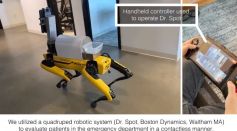Tags: MIT

Physicists Achieve Quantum State on Larger Object by Freezing Human-Scale Mirror

Previously Unidentified Galaxy Clusters Discovered Passing Thru Sea of Hot Gas

Mobile Robot Dr. Spot Used in Hospital to Reduce COVID-19 Spread
New Generation of Insect-Inspired Smaller, Faster Drones Introduced
Tunable Heisenberg Model Based on “Ultracold Atoms” Observes New Quantum Behavior

Giving Cells a "Squeeze" Makes Them Divide Faster

MIT Develops Sleep-Tracking Device That Alters Dreams to Boost Creativity
This New Device Can Manipulate Your Dreams While You Sleep
Muscle Signal Lets You Pilot A Drone To Survey Sites Or Inspect Off-Shore Platforms That Are Hard To Reach

AI Predicts “A Halting Of Infections” Around April 20th But Warns Catastrophe If Social Distancing Relax Too Soon
MIT Has Overcome iOS and Android Issues Making Coronavirus Contact Tracking App Possible

Researchers Develops Ways to Deflect ‘Planet Killer’ Asteroid Hitting Earth

Research on Electrolysis Leads to a More Environmentally Friendly Way of Producing Cement

No more needles: New capsule design just as effective as injections
PhD Student at MIT Hopes to Revolutionize Insulin Administration
MIT’s Annual 2.007 Competition Pays Homage to Apollo 11
MIT and Harvard Receive $4.5 Million Each for Marijuana Research from Former Student
MIT IDEAS Challenge Showcase Continues to Pump Out World Changing Ideas
Yarn-like Nanofibers Could Assist in the Healing of Tendons and Muscles
MIT Engineered Surface Treatment to Reduce Waste and Improve Efficiency
Most Popular

Viruses vs Bacteria: Key Differences, How They Spread, and How We Treat Them

How Ice Cores Reveal Climate History: Insights from Paleoclimate Science and Ancient Data

Space Debris and Orbital Pollution: Rising Space Junk Threats and Collision Risks Around Earth

Recycling Myths vs Facts: What Actually Gets Recycled and How to Do It Right





